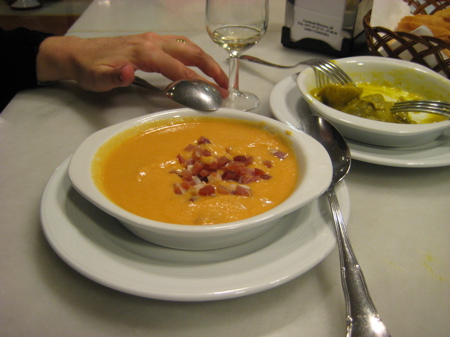
Teresa Parker blogs about restaurants, recipes, and the reasons why she's in love with Spain's food and culture.
Step away from the red gazpacho. Red means canned tomatoes or tomato juice have gone into the hopper. Both lend a distinctly cooked flavor to a soup that is supposed to be all about fresh summer produce. Here's the thing: Gazpacho's true colors range from pink to orange to white, never red.

The pink-orange versions are tomato-based salads whose other ingredients vary from province to province and kitchen to kitchen. Salmorejo, the Cordobés version, has no vegetables other than tomatoes. Madrileños are known for insisting on including onion. Some cooks add a pinch of cumin -- but hold back there, gazpacho is never spicy either. Like Italian panzanella, these salads always include day-old bread and are dressed with salt, good olive oil, and vinegar. The difference is that the Spaniards blend the whole thing into a soup and knock it back cold.
Gazpacho
Serves 4
2 lbs. (about 6) ripe summer tomatoes
1 cucumber
1 green or red pepper
1/2 onion
1 clove garlic, peeled
1/4 C extra virgin olive oil
2 Tbsp. red wine or sherry vinegar
1 four-inch hunk of day-old country bread, crust removed
3 C cold water
salt
Pour the cold water into a bowl and drop in the bread to soak while you get the vegetables going. Cut tomatoes crosswise and seed them (this doesn’t have to be exacting, just gouge out the seed sections with your fingers – I do it over a colander and catch the juices that slosh out to add them to the soup; toss tomatoes into blender or processor.
Blend away as you go: cut the cukes into chunks and add them, slice the pepper off its seeds and add it, add the onion and garlic. Take the bread out of the water, add it, and keep blending.
Dress the mixture with the olive oil, vinegar, and a couple of hefty pinches of salt. Add water to adjust the texture (it can be thick and spoonable or thin enough to drink from a glass). Taste and correct for dressing and salt.
Chill thoroughly.
Flourishes: Don’t be afraid to vary the vegetable proportions depending on what you’ve got on hand. Add a pinch of ground cumin. Garnish with olive-oil fried croutons, chopped tomatoes, cukes, peppers, and onion. Chopped hard-boiled eggs are popular in some quarters too. In Córdoba, ham is the garnish of choice.
The white stuff is a version traditionally made in Málaga and known as Ajo Blanco (white garlic). Its vegetable-bereft ingredients list may sound strange but the almonds, garlic, and grapes are lovely together:
Ajo Blanco
Serves 4
1 1/2 C blanced almonds
1 clove garlic, peeled
1/4 C extra virgin olive oil
3 Tbsp. sherry vinegar
1 four-inch hunk of day-old country bread, crust removed
3 C cold water salt
Pour the cold water into a bowl and drop in the bread to soak while you start blending the almonds. Blend almonds and garlic into a smooth paste. Add oil and vinegar and blend some more. Take the bread out of the water, add it, and keep blending.
Season with a couple of hefty pinches of salt. Add water to adjust the texture. Taste and correct for dressing and salt. Chill thoroughly.
Garnish: This soup really needs its garnish to balance the flavors sensibly. Moscatel grapes, halved and seeded are the classic garnish. Chopped apple and raisins are common alternative flourishes.
